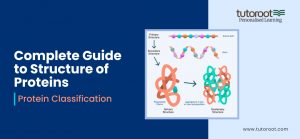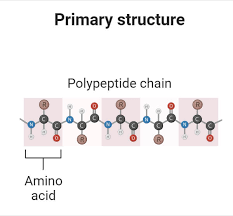What is the Complete Guide to Structure of Proteins?

Proteins are essential to life, playing a crucial role in a wide range of biological processes. As one of the most extensively studied biomolecules in both biology and chemistry, proteins are vital to understanding how life functions. A comprehensive grasp of protein structure is necessary to fully appreciate their diverse functions, interactions, and roles within living organisms. This guide provides an in-depth exploration of protein structure, classification, and the various levels of their organization.
What is the Structure of Protein?
Protein structure refers to the three-dimensional arrangement of amino acid chains within a protein. Proteins are made up of long chains of amino acids connected by peptide bonds, which fold into specific shapes influenced by the sequence of amino acids and the interactions between them. The unique structure of each protein determines its function, whether it’s acting as an enzyme to catalyze reactions, providing structural support, or facilitating cellular communication.
Proteins are constructed from 20 different amino acids, each with distinctive side chains that affect the protein’s overall shape and properties. The sequence of amino acids in a protein is encoded by genes, and even a minor change in this sequence can significantly impact the protein’s function.
Protein structure is organized into four distinct levels:
- Primary Structure: This is the linear sequence of amino acids in a polypeptide chain, representing the most basic level of protein structure, as determined by the genetic code.
- Secondary Structure: This stage refers to the specific folding of the polypeptide chain into configurations such as alpha helices and beta sheets, which are maintained by hydrogen bonds.
- Tertiary Structure: This refers to the overall three-dimensional folding of the entire polypeptide chain, resulting from various interactions between side chains.
- Quaternary Structure: This structural level isn’t present in all proteins. It refers to the combination of multiple polypeptide chains forming a functional protein complex.
Protein Structure Diagram
A protein structure diagram visually represents the different levels of protein structure. It typically displays the primary structure as a simple linear sequence of amino acids, highlights secondary structures such as alpha helices and beta sheets, and shows the complex, folded three-dimensional shape of the tertiary structure. The quaternary structure, if present, illustrates the interaction of multiple polypeptide chains.
These diagrams are essential for visualizing how proteins achieve their functional forms and for understanding the spatial arrangement of different structural components, which is crucial for grasping how proteins interact with other molecules.

Classification of Proteins
Proteins can be classified based on their structure and function. The two primary categories are fibrous proteins and globular proteins.
Fibrous Proteins
Fibrous proteins are elongated, thread-like structures that are insoluble in water. They mainly provide structural support and are found in tissues such as tendons, ligaments, and skin. Their extended, linear shape allows them to form strong fibers, making them ideal for mechanical support.
Examples of fibrous proteins include:
- Collagen: The most abundant protein in mammals, collagen is a key component of connective tissues, providing tensile strength to skin, bones, and tendons.
- Keratin: Present in hair, nails, and the outer layer of skin, keratin is a durable, protective protein that provides structural support.
Fibrous proteins have a simple, repetitive sequence that enables the formation of stable, strong structures. They primarily serve structural roles rather than functional ones and typically do not undergo significant conformational changes.
Globular Proteins
Globular proteins are compact, spherical proteins that are soluble in water. Unlike fibrous proteins, they play a role in a wide variety of biological functions, including catalysis, transport, and regulation. Their complex three-dimensional shapes are crucial to their functions.
Examples of globular proteins include:
- Hemoglobin: A protein in red blood cells responsible for transporting oxygen from the lungs to the rest of the body.
- Enzymes: These are proteins that function as biological catalysts, accelerating chemical reactions within the body.
Globular proteins have dynamic structures that allow them to interact with various molecules. They are generally more complex than fibrous proteins and can undergo significant conformational changes during their function.

Levels of Protein Structure
Primary Structure of Protein
A protein’s primary structure is its unique sequence of amino acids, determined by the organism’s DNA. This sequence is critical for the protein’s final shape and function, dictating how the protein will fold into its secondary, tertiary, and quaternary structures.
Each amino acid in the sequence is connected by a peptide bond, creating a polypeptide chain. Even a single alteration in this sequence, such as a mutation, can result in a non-functional protein or cause diseases.
Secondary Structure of Protein
The secondary structure of a protein refers to the local folding of the polypeptide chain into specific patterns, such as alpha helices and beta sheets. These structures are maintained by hydrogen bonds that form between the backbone atoms of the amino acids.
- Alpha Helices: Coiled structures resembling a spiral staircase, with amino acid side chains extending outward. Alpha helices are common in many proteins and contribute to their stability and flexibility.
- Beta Sheets: Sheet-like structures formed by linking two or more strands of a polypeptide chain through hydrogen bonds. Beta sheets can be parallel or antiparallel, depending on the direction of the strands.
These secondary structures are essential for the protein’s overall folding and stability, as they bring distant parts of the polypeptide chain closer together.
Tertiary Structure of Protein
The tertiary structure is the overall three-dimensional shape of a protein, formed by the folding of its secondary structures. This structural level is supported by various interactions, including hydrogen bonds, ionic bonds, hydrophobic interactions, and disulfide bridges.
The tertiary structure is vital for the protein’s function, as it determines both the position of active sites and the overall three-dimensional shape of the protein. For instance, the tertiary structure of enzymes is vital for their ability to bind to substrates and catalyze reactions.
Tertiary Structure of Protein Example
An example of a protein with a well-defined tertiary structure is myoglobin, a globular protein that stores oxygen in muscle cells. Its compact, globular shape allows it to efficiently bind and release oxygen molecules.
Protein Structure and Function
The structure of a protein is intimately connected to its function. The specific shape and folding pattern of a protein enables it to interact with other molecules in precise ways. For example, enzymes have active sites that fit specific substrates, much like a key fits into a lock.
Proteins carry out a variety of functions within living organisms, including:
- Catalysis: Enzymes accelerate chemical reactions, making them essential for metabolism.
- Transport: Proteins such as hemoglobin are involved in carrying molecules like oxygen throughout the body.
- Support: Structural proteins like collagen provide strength and support to tissues.
- Defence: Antibodies are proteins that protect the body from pathogens.
Without the correct structure, proteins cannot perform these functions, leading to various diseases and disorders.
Final Notes
Proteins are vital biomolecules with intricate structures that dictate their functions. Understanding the structure of proteins, from the basic sequence of amino acids to the more intricate tertiary and quaternary structures, is crucial for comprehending their roles in biological processes.
If you’re eager to deepen your understanding of concepts like these, the Tutoroot Blog is your go-to resource for clear, student-friendly explanations. For personalised learning and to tackle challenging topics with ease, consider Tutoroot’s Chemistry Online Tuition. Take the next step towards academic success by booking a FREE DEMO session with Tutoroot’s expert tutors today.
FAQs
Define protein configuration
Protein configuration refers to the specific three-dimensional arrangement of a protein’s amino acid chain. This configuration is critical for the protein’s function and is determined by the sequence of amino acids.
What are the types of protein?
Proteins can be broadly classified into fibrous and globular proteins. Fibrous proteins provide structural support, while globular proteins are involved in various functions, including catalysis, transport, and regulation.
